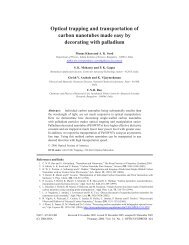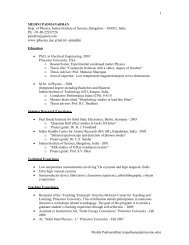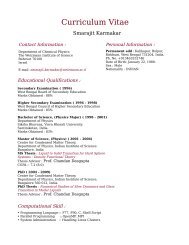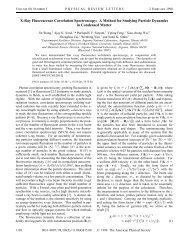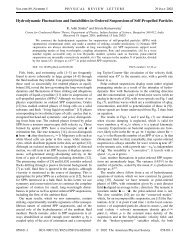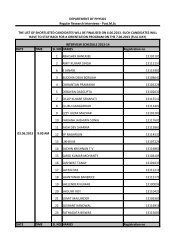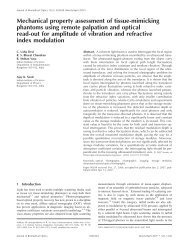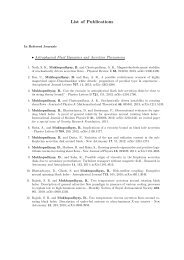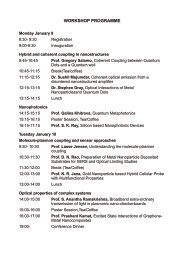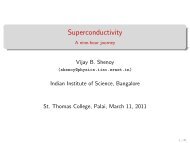Order and chaos in soft condensed matter - Physics - Indian Institute ...
Order and chaos in soft condensed matter - Physics - Indian Institute ...
Order and chaos in soft condensed matter - Physics - Indian Institute ...
You also want an ePaper? Increase the reach of your titles
YUMPU automatically turns print PDFs into web optimized ePapers that Google loves.
PRAMANA c○ <strong>Indian</strong> Academy of Sciences Vol. 67, No. 1<br />
— journal of July 2006<br />
physics pp. 33–46<br />
<strong>Order</strong> <strong>and</strong> <strong>chaos</strong> <strong>in</strong> <strong>soft</strong> <strong>condensed</strong> <strong>matter</strong><br />
A K SOOD <strong>and</strong> RAJESH GANAPATHY<br />
Department of <strong>Physics</strong>, <strong>Indian</strong> <strong>Institute</strong> of Science, Bangalore 560 012, India<br />
E-mail: asood@physics.iisc.ernet.<strong>in</strong><br />
Abstract. Soft <strong>matter</strong>, like colloidal suspensions <strong>and</strong> surfactant gels, exhibit strong response<br />
to modest external perturbations. This paper reviews our recent experiments on<br />
the nonl<strong>in</strong>ear flow behaviour of surfactant worm-like micellar gels. A rich dynamic behaviour<br />
exhibit<strong>in</strong>g regular, quasi-periodic, <strong>in</strong>termittency <strong>and</strong> <strong>chaos</strong> is observed. In particular,<br />
we have shown experimentally that the route to <strong>chaos</strong> is via Type-II <strong>in</strong>termittency <strong>in</strong><br />
shear th<strong>in</strong>n<strong>in</strong>g worm-like micellar solution of cetyltrimethylammonium tosylate where the<br />
strength of flow-concentration coupl<strong>in</strong>g is tuned by the addition of sodium chloride. A<br />
Po<strong>in</strong>caré first return map of the time series <strong>and</strong> the probability distribution of lam<strong>in</strong>ar<br />
length between burst events show that our data are consistent with Type-II <strong>in</strong>termittency.<br />
The existence of a ‘Butterfly’ <strong>in</strong>tensity pattern <strong>in</strong> small angle light scatter<strong>in</strong>g (SALS)<br />
measurements performed simultaneously with the rheological measurements confirms the<br />
coupl<strong>in</strong>g of flow to concentration fluctuations <strong>in</strong> the system under study. The scattered<br />
depolarised <strong>in</strong>tensity <strong>in</strong> SALS, sensitive to orientational order fluctuations, shows the same<br />
time-dependence (like <strong>in</strong>termittency) as that of shear stress.<br />
Keywords. Surfactants; stress relaxation; flow <strong>in</strong>stabilities; rheo-optics.<br />
PACS Nos<br />
82.70.Uv; 83.85.St; 83.85.Ei; 82.70.Gg; 83.60.Wc<br />
1. Introduction<br />
Soft <strong>condensed</strong> <strong>matter</strong> (SCM) systems are ubiquitous <strong>in</strong> nature. Colloidal suspensions,<br />
surfactant gels <strong>and</strong> polymeric systems are just a few examples [1]. Soft<br />
<strong>matter</strong> is middle ground between two extremes: the fluid state, where thermal<br />
fluctuations are very important, <strong>and</strong> the solid state. However diverse these systems<br />
are, they share certa<strong>in</strong> common features: (i) The constituents that make<br />
up <strong>soft</strong> <strong>matter</strong> are large polyatomic structures. The focus is not on atomic details<br />
<strong>and</strong> a coarse gra<strong>in</strong>ed approach is taken <strong>in</strong> underst<strong>and</strong><strong>in</strong>g these materials. (ii)<br />
Self-organisation is a very important feature of these systems. The polyatomic<br />
molecules self-assemble to form large heterostructures on chang<strong>in</strong>g either their concentration<br />
or <strong>in</strong>creas<strong>in</strong>g/decreas<strong>in</strong>g temperature. For example, on chang<strong>in</strong>g the<br />
concentration of the amphiphilic molecules, one can go from monomers to micelles<br />
to cubic/hexagonal/lamellar phases. (iii) These materials show strong response to<br />
modest external perturbations like shear flow, electric, magnetic <strong>and</strong> gravitational<br />
fields <strong>and</strong> hence are <strong>in</strong>terest<strong>in</strong>g c<strong>and</strong>idates for the study of non-equilibrium phenomena.<br />
(iv) These materials are weakly connected <strong>and</strong> have low density. The<br />
33
A K Sood <strong>and</strong> Rajesh Ganapathy<br />
Figure 1. Schematic of a Couette flow between two parallel plates. (a) Homogenous<br />
flow <strong>and</strong> (b) shear b<strong>and</strong>ed flow. The arrows <strong>in</strong>dicate the magnitude<br />
of the flow velocity.<br />
elastic constants are very low compared to atomic systems. For example, a colloidal<br />
gel/crystal has typical elastic modulus ∼10 Pa whereas the elastic modulus<br />
of steel is ∼10 12 Pa [2–4].<br />
The effect of shear flow on these materials has aroused immense <strong>in</strong>terest <strong>in</strong> recent<br />
times. Figure 1a shows a schematic of the planar Couette flow arrangement [5], one<br />
of the st<strong>and</strong>ard ways to apply shear. The material of <strong>in</strong>terest is held between two<br />
parallel plates separated by a distance d <strong>and</strong> the top plate is moved with a velocity<br />
v while the bottom plate is held fixed. The shear rate ˙γ is given by, ˙γ = v/d.<br />
Shear has units of 1/s <strong>and</strong> hence τ Shear = 1/ ˙γ is the time-scale set by the shear<br />
flow. The typical relaxation time of stress, τ Relax , <strong>in</strong> <strong>soft</strong> materials is 10 −3 s, unlike<br />
conventional solids where the relaxation time τ Relax ∼ 10 −12 s. The large relaxation<br />
time of SCM systems imply that ˙γτ Relax ∼ 1 can be achieved <strong>in</strong> these systems. Thus<br />
<strong>in</strong> SCM systems shear flow is coupled to the microstructure unlike conventional<br />
solids, where one needs to apply <strong>in</strong>credibly large shear rates that are unatta<strong>in</strong>able<br />
<strong>in</strong> a typical experiment before one sees such a coupl<strong>in</strong>g. It is useful to def<strong>in</strong>e a<br />
dimensionless number called the Peclet number P e given by P e = τ Diff /τ Shear where,<br />
τ Diff is the Brownian diffusion time <strong>and</strong> is given by τ Diff ∼ 6πηa 3 /k B T . Here a is<br />
the radius of the macromolecule, η is the viscosity, k B is the Boltzmann constant<br />
<strong>and</strong> T is the temperature. If P e ≪ 1 (i.e. τ Diff ≪ τ Shear ), Brownian motion is able<br />
to ma<strong>in</strong>ta<strong>in</strong> an unperturbed state. If P e ≫ 1 imply<strong>in</strong>g τ Diff ≫ τ Shear , the shear<br />
flow modifies the structure <strong>and</strong> Brownian motion is unable to restore structure on<br />
a time-scale set by the shear rate.<br />
The ma<strong>in</strong> focus of this article is our ongo<strong>in</strong>g study of worm-like micellar gels of<br />
surfactant cetyltrimethylammonium tosylate which shows a rich dynamic behaviour<br />
under shear flow.<br />
2. Surfactants<br />
Surfactants are amphiphilic molecules compris<strong>in</strong>g of a polar head group <strong>and</strong> a hydrophobic<br />
long cha<strong>in</strong> hydrocarbon tail [6]. This amphiphilic nature of the molecule<br />
gives rise to a variety of phases <strong>in</strong> an aqueous medium s<strong>in</strong>ce the polar head group<br />
prefers to stay <strong>in</strong> water whereas the hydrocarbon tail tries to shield itself from<br />
water. In a polar solvent at very low concentrations, they exist as monomers.<br />
On <strong>in</strong>creas<strong>in</strong>g the surfactant concentration beyond critical micellar concentration<br />
34 Pramana – J. Phys., Vol. 67, No. 1, July 2006
<strong>Order</strong> <strong>and</strong> <strong>chaos</strong> <strong>in</strong> <strong>soft</strong> <strong>condensed</strong> <strong>matter</strong><br />
Figure 2. Phase diagram of CTAT [8]. I: Isotropic phase, H: hexagonal<br />
phase <strong>and</strong> C: cubic phase.<br />
(CMC), they form spherical micelles with the polar head groups po<strong>in</strong>t<strong>in</strong>g out <strong>and</strong><br />
tails po<strong>in</strong>t<strong>in</strong>g <strong>in</strong>. At higher concentrations, these spherical micelles can elongate<br />
to form long flexible cyl<strong>in</strong>drical micelles which above the overlap concentration c ∗<br />
entangle to form viscoelastic gels [7]. At very high concentrations they can form<br />
ordered phases like hexagonal, cubic <strong>and</strong> lamellar phases. The phase behaviour<br />
of the cationic surfactant CTAT has been well-characterised by Soltero et al [8]<br />
(figure 2). Above the Krafft temperature of 23 ◦ C <strong>and</strong> at concentrations 0.04 wt%<br />
< c < 0.4 wt% cyl<strong>in</strong>drical micelles are formed which, at c > c ∗ = 0.4 wt%, entangle<br />
to form viscoelastic gels.<br />
3. Experimental<br />
The CTAT/water <strong>and</strong> CTAT/NaCl/water samples were prepared by dissolv<strong>in</strong>g<br />
known amounts of CTAT (formula wt: 455.7, Sigma Aldrich) <strong>in</strong> water <strong>and</strong> br<strong>in</strong>e,<br />
respectively, <strong>and</strong> this study ma<strong>in</strong>ly focuses on the latter. The samples were filtered<br />
through 200 nm pore size filters to remove dust impurities <strong>and</strong> left to equilibrate<br />
for two days. The experiments were carried out on a MCR 300 stress-controlled<br />
rheometer (Anton PAAR, Germany) with small angle light scatter<strong>in</strong>g attachment<br />
(SALS) at a temperature of 26.5 ◦ C (figure 3). The rheometer is <strong>in</strong>tr<strong>in</strong>sically stresscontrolled<br />
<strong>and</strong> was used <strong>in</strong> the feedback mode for stra<strong>in</strong>-controlled experiments.<br />
All experiments were carried out <strong>in</strong> a cyl<strong>in</strong>drical Couette geometry with top <strong>and</strong><br />
bottom w<strong>in</strong>dows made of quartz glass (<strong>in</strong>ner cyl<strong>in</strong>der diameter 32 mm, height 16.5<br />
mm <strong>and</strong> gap 2 mm). A vertically polarised (V) laser beam (λ = 658 nm <strong>and</strong> spot<br />
size = 1 mm) enters the gap between the cyl<strong>in</strong>ders (the beam is close to the <strong>in</strong>ner<br />
rotat<strong>in</strong>g cyl<strong>in</strong>der <strong>and</strong> cannot be translated across the gap) along the vorticity<br />
(∇ × v) direction, where v is the velocity field. An analyser below the Couette<br />
geometry allows us to select either the vertically (referred as VV) or the horizontally<br />
polarised (referred as VH) scattered light from the sample without disturb<strong>in</strong>g<br />
Pramana – J. Phys., Vol. 67, No. 1, July 2006 35
A K Sood <strong>and</strong> Rajesh Ganapathy<br />
Figure 3. Schematic of the rheo-small angle light scatter<strong>in</strong>g set-up.<br />
the measurements. A condenser beneath the analyser collects the scattered light<br />
dom<strong>in</strong>antly from a plane 6 mm above the bottom plate <strong>and</strong> forms the image on<br />
a screen <strong>in</strong> the (v, ∇v) plane. The imag<strong>in</strong>g was done us<strong>in</strong>g a 8-bit colour CCD<br />
camera (Lumenera 075C, 640 × 480 pixels, maximum frame rate = 60 fps) at a<br />
frame rate of 1 frame/750 ms. About 3000 images were grabbed for each polarisation<br />
while stress relaxation measurements were simultaneously go<strong>in</strong>g on. The<br />
<strong>in</strong>tensity at various wave vectors from the noise filtered image was measured <strong>and</strong> a<br />
time series was generated by repeat<strong>in</strong>g the process over each image.<br />
4. Background<br />
In a l<strong>in</strong>ear rheology experiment, one studies the response of a material to very small<br />
stresses (i.e. small compared to the thermal fluctuations <strong>in</strong> the material) [9]. Nonl<strong>in</strong>ear<br />
rheology describes the response of a material to large stresses <strong>and</strong> it is <strong>in</strong> this<br />
regime one sees novel flow behaviour [5]. As the name suggests, the stra<strong>in</strong> developed<br />
<strong>in</strong> the sample changes nonl<strong>in</strong>early with the applied stress <strong>in</strong> this regime. The nonl<strong>in</strong>ear<br />
flow behaviour is characterized by shear th<strong>in</strong>n<strong>in</strong>g or thicken<strong>in</strong>g, the presence of<br />
non-zero yield stresses <strong>and</strong> normal stress differences, flow-<strong>in</strong>duced phase transitions<br />
<strong>and</strong> the phenomenon of shear b<strong>and</strong><strong>in</strong>g. Systems of giant worm-like micelles formed<br />
<strong>in</strong> certa<strong>in</strong> surfactant solutions are known to show very unusual nonl<strong>in</strong>ear rheology.<br />
In a controlled stress measurement of the flow curve the stress is known to saturate<br />
beyond a critical shear rate, while the first normal stress difference <strong>in</strong>creases<br />
roughly l<strong>in</strong>early with shear rate. Cates <strong>and</strong> coworkers were the first to predict this<br />
k<strong>in</strong>d of flow behaviour <strong>and</strong> they attribute this to a mechanical <strong>in</strong>stability of the<br />
36 Pramana – J. Phys., Vol. 67, No. 1, July 2006
<strong>Order</strong> <strong>and</strong> <strong>chaos</strong> <strong>in</strong> <strong>soft</strong> <strong>condensed</strong> <strong>matter</strong><br />
shear b<strong>and</strong><strong>in</strong>g type [10]. In shear b<strong>and</strong><strong>in</strong>g systems, the system splits <strong>in</strong>to coexist<strong>in</strong>g<br />
b<strong>and</strong>s that support the same stress but have different average shear rates (figure<br />
1b). The high shear rate b<strong>and</strong> is lower <strong>in</strong> viscosity <strong>and</strong> is the nematic phase, while<br />
the low shear b<strong>and</strong> has a higher viscosity <strong>and</strong> is the isotropic phase. This k<strong>in</strong>d of<br />
behaviour may be understood <strong>in</strong> terms of the reptation-reaction model which <strong>in</strong>volves<br />
the reversible breakage <strong>and</strong> recomb<strong>in</strong>ation of worm-like micelles along with<br />
reptation dynamics known for polymer solutions. The flow curve can be measured<br />
under controlled stress or stra<strong>in</strong> rate <strong>and</strong> depend<strong>in</strong>g on the time <strong>in</strong>terval between<br />
the collection of data po<strong>in</strong>ts, we can obta<strong>in</strong> metastable or steady state branches,<br />
respectively.<br />
In shear th<strong>in</strong>n<strong>in</strong>g worm-like micellar solutions of surfactant cetyltrimethylammonium<br />
tosylate (CTAT) that shows a plateau <strong>in</strong> the flow curve, B<strong>and</strong>yopadhyay<br />
et al found <strong>in</strong>terest<strong>in</strong>g time dependence <strong>in</strong> the relaxation of the stress <strong>and</strong> normal<br />
force <strong>in</strong> step shear rate experiments for shear rate values fixed <strong>in</strong> the plateau<br />
region [11]. A time series analysis of the stress data us<strong>in</strong>g the delay-embedd<strong>in</strong>g<br />
method, done us<strong>in</strong>g the TISEAN <strong>soft</strong>ware [12], showed the existence of a positive<br />
Lyapunov exponent, a measure of divergence of trajectories <strong>in</strong> phase space, <strong>and</strong> a<br />
fractal correlation dimension >2 imply<strong>in</strong>g that the signal was chaotic rather than<br />
the stochastic noise. This has led to many theoretical [13–17] <strong>and</strong> experimental<br />
studies of this strik<strong>in</strong>g effect, termed as ‘rheo<strong>chaos</strong>’, <strong>in</strong> a wide variety of other systems<br />
<strong>in</strong>clud<strong>in</strong>g shear-thicken<strong>in</strong>g worm-like micellar solutions [18], lamellar, onion<br />
<strong>and</strong> sponge phases of surfactants [19] <strong>and</strong> dense colloidal suspensions [20]. NMR<br />
velocimetry <strong>and</strong> rheo-optical experiments suggest that rheo<strong>chaos</strong> is closely l<strong>in</strong>ked<br />
to the phenomenon of shear b<strong>and</strong><strong>in</strong>g [21]. These experiments have shown that the<br />
<strong>in</strong>terface between the shear rate b<strong>and</strong>s is not stable as predicted [10], but shows<br />
complex spatio-temporal dynamics <strong>and</strong> this is accompanied by stress/shear rate<br />
fluctuations. Spatial heterogeneity should play a role <strong>in</strong> underst<strong>and</strong><strong>in</strong>g rheo<strong>chaos</strong><br />
as exploited <strong>in</strong> recent theoretical models [22,23].<br />
These experiments raised three important questions that have rema<strong>in</strong>ed unaddressed<br />
<strong>in</strong> experimental literature so far:<br />
1. What is the route to rheo<strong>chaos</strong>?<br />
2. Does a concentration difference between the shear b<strong>and</strong>s affect rheo<strong>chaos</strong>?<br />
3. What is the role played by the nematic alignment of the worm-like micelles<br />
on rheo<strong>chaos</strong>?<br />
There are primarily three routes to <strong>chaos</strong>: the period-doubl<strong>in</strong>g route, the quasiperiodic<br />
route <strong>and</strong> the <strong>in</strong>termittency route. The <strong>in</strong>termittency route is ma<strong>in</strong>ly<br />
characterised by bursts of <strong>chaos</strong> disrupt<strong>in</strong>g nearly periodic (lam<strong>in</strong>ar region) oscillations.<br />
Pomeau <strong>and</strong> Manneville [24] have established that with<strong>in</strong> the <strong>in</strong>termittency<br />
route there are further three types. Type-I appears with an <strong>in</strong>verse tangent bifurcation,<br />
Type-II with a Hopf bifurcation <strong>and</strong> Type-III is associated with a period<br />
doubl<strong>in</strong>g bifurcation. Experimentally, all three types of <strong>in</strong>termittency have been<br />
observed <strong>in</strong> a variety of hydrodynamical <strong>and</strong> electrical systems [25], although there<br />
are fewer examples of Type-II <strong>in</strong>termittency which sets <strong>in</strong> via quasi-periodicity.<br />
Our experiments, we show below, are consistent with Type-II <strong>in</strong>termittency route<br />
to <strong>chaos</strong>.<br />
Pramana – J. Phys., Vol. 67, No. 1, July 2006 37
5. Motivation<br />
A K Sood <strong>and</strong> Rajesh Ganapathy<br />
In a recent theoretical study, Field<strong>in</strong>g <strong>and</strong> Olmsted [26] have taken <strong>in</strong>to account the<br />
effect of concentration coupl<strong>in</strong>g <strong>in</strong> shear b<strong>and</strong><strong>in</strong>g worm-like micellar systems that<br />
are far from zero-shear isotropic–nematic (I–N) transition. Their d-JS-φ model<br />
(spatially non-local Johnson–Segalman model with concentration coupl<strong>in</strong>g) calculations<br />
predict a positive value for the slope of the plateau <strong>in</strong> the b<strong>and</strong>ed region<br />
of the flow curve, <strong>and</strong> the slope <strong>in</strong>creases with the strength of the coupl<strong>in</strong>g between<br />
flow <strong>and</strong> concentration fluctuations (figure 4). In a recent experimental<br />
work, B<strong>and</strong>yopadhyay <strong>and</strong> Sood [27] have shown that the slope α of the stress<br />
plateau, which we f<strong>in</strong>d is a power law σ ∼ γ α , for worm-like micellar solutions of<br />
surfactant cetyltrimethylammonium tosylate (CTAT) can be tuned by add<strong>in</strong>g salt<br />
(NaCl) (figure 5).<br />
These results motivated us to study the consequences of flow-concentration coupl<strong>in</strong>g<br />
on the stress relaxation dynamics <strong>in</strong> this class of systems.<br />
6. Results <strong>and</strong> discussion<br />
Figure 6a (filled circles) shows the flow curve for CTAT 2 wt% <strong>in</strong> a controlled-stress<br />
experiment. The flow curve shows a near-plateau for ˙γ > 0.1 s −1 . The observed<br />
weak departure (slope α = 0.07 <strong>in</strong> the log–log plot) from a true plateau is very likely<br />
due to the small <strong>in</strong>homogeneity of the stress field aris<strong>in</strong>g from curvature effects <strong>in</strong><br />
the cyl<strong>in</strong>drical Couette geometry [26]. The <strong>in</strong>crease <strong>in</strong> stress due to geometry<br />
curvature alone has been calculated us<strong>in</strong>g the relation:<br />
∆σ<br />
σ<br />
= 2∆R<br />
R . (1)<br />
Here, ∆σ is the <strong>in</strong>crease <strong>in</strong> stress across the plateau due to cell curvature, σ is the<br />
stress at the plateau onset, ∆R is the gap between the cyl<strong>in</strong>ders <strong>and</strong> R is the radius<br />
Figure 4. Theoretical prediction for a system show<strong>in</strong>g flow-concentration<br />
coupl<strong>in</strong>g. The red l<strong>in</strong>e B ′ F ′ is when the shear b<strong>and</strong>s have different concentrations.<br />
The l<strong>in</strong>e BF is for a system that does not show a concentration<br />
difference between the shear b<strong>and</strong>s [26].<br />
38 Pramana – J. Phys., Vol. 67, No. 1, July 2006
<strong>Order</strong> <strong>and</strong> <strong>chaos</strong> <strong>in</strong> <strong>soft</strong> <strong>condensed</strong> <strong>matter</strong><br />
Figure 5. Magnitude of slope of the flow curve plotted aga<strong>in</strong>st NaCl concentration<br />
for CTAT surfactant concentration of 2 wt%.<br />
Figure 6. (a) Flow curves for CTAT 2 wt% (solid circles) <strong>and</strong> CTAT 2 wt%<br />
+ 100 mM NaCl (hollow circles). Inset: Flow curve for CTAT 2 wt% + 50<br />
mM NaCl. (b) SALS profiles for (i) <strong>and</strong> (iii) CTAT 2 wt% for VV <strong>and</strong> VH<br />
polarizations <strong>and</strong> (ii) <strong>and</strong> (iv) CTAT 2 wt% + 100 mM NaCl for VV <strong>and</strong> VH<br />
polarizations [30].<br />
of the <strong>in</strong>ner cyl<strong>in</strong>der. The <strong>in</strong>crease <strong>in</strong> stress calculated us<strong>in</strong>g (1) is 1.6 Pa for pure<br />
CTAT 2 wt% which is <strong>in</strong> good agreement with the experimental value of ∼1.3 Pa.<br />
Figure 6a also shows the flow curve for CTAT 2 wt% + 100 mM NaCl (hollow circles).<br />
The stress shows a much stronger shear rate dependence (α = 0.32 for CTAT<br />
2 wt% + 100 mM NaCl <strong>and</strong> α = 0.24 for CTAT 2 wt% + 50 mM NaCl; see figure<br />
6a, <strong>in</strong>set) above ˙γ > 1 s −1 which cannot be due to geometry effects alone. We attribute<br />
this slope to a concentration difference between the shear rate b<strong>and</strong>s [22,26].<br />
Berret et al [23] found similar values of slope for the system CpCl/hexanol/NaCl<br />
Pramana – J. Phys., Vol. 67, No. 1, July 2006 39
A K Sood <strong>and</strong> Rajesh Ganapathy<br />
for concentrations just below the I–N coexistence concentration of 32 wt%. Our<br />
system is <strong>in</strong> the semi-dilute region <strong>and</strong> is far from a zero-shear I–N transition ∼27<br />
wt% for pure CTAT <strong>and</strong> >30 wt% for CTAT + 50 mM NaCl. Hence, a large slope<br />
α is not due to I–N coexistence. A concentration difference between the shear rate<br />
b<strong>and</strong>s can arise from a Helf<strong>and</strong>–Fredrickson mechanism [28]. In a sheared micellar<br />
solution, the portion of the micelle mired <strong>in</strong> the low viscosity shear b<strong>and</strong>, on relax<strong>in</strong>g<br />
will move more than the micelle trapped <strong>in</strong> the high viscosity region. Hence<br />
on average the molecule moves towards the low shear rate b<strong>and</strong>. This mechanism<br />
provides a positive feedback whereby micelles can move up their own concentration<br />
gradients <strong>and</strong> thereby lead to flow-enhanced concentration fluctuations. The high<br />
shear rate b<strong>and</strong> is predicted to be lower <strong>in</strong> concentration than the low shear rate<br />
b<strong>and</strong>. If so, our SALS experiments should show a ‘Butterfly’ light scatter<strong>in</strong>g pattern<br />
with the w<strong>in</strong>gs of the butterfly stretched along the flow direction [29]. Figure<br />
6b shows the SALS pattern <strong>in</strong> VV geometry for CTAT 2 wt% <strong>and</strong> CTAT 2 wt% +<br />
100 mM NaCl. The ‘Butterfly’ pattern is absent for the pure CTAT 2 wt% (figure<br />
6b(i)) <strong>and</strong> is present for CTAT 2 wt% + 100 mM NaCl (figure 6b(ii)) <strong>and</strong> (iii) <strong>and</strong><br />
(iv) <strong>in</strong> figure 6b show correspond<strong>in</strong>g patterns <strong>in</strong> VH geometry. We have carried out<br />
experiments at six different salt concentrations 10 mM < c NaCl < 1 M, which yield<br />
plateau slopes rang<strong>in</strong>g from 0.07 < α < 0.4 (figure 5). We f<strong>in</strong>d that a m<strong>in</strong>imum<br />
slope of 0.12, correspond<strong>in</strong>g to a salt concentration of 25 mM NaCl, is essential to<br />
see a ‘Butterfly’ pattern <strong>in</strong>dicat<strong>in</strong>g the onset of flow-concentration coupl<strong>in</strong>g at this<br />
α value [30].<br />
Figures 7a–e show the stress relaxation dynamics for various shear rates fixed <strong>in</strong><br />
the plateau region for the system CTAT 2 wt% + 100 mM NaCl. At a ˙γ = 0.05 s −1<br />
the stress does not show any dynamics. As the shear rate is <strong>in</strong>creased to ˙γ = 10 s −1 ,<br />
the stress oscillations look periodic (figure 7b). At ˙γ = 20 s −1 the system shows<br />
oscillations with two modes that appear twice dur<strong>in</strong>g the course of the experiment.<br />
Figure 7d shows the stress relaxation dynamics at ˙γ = 23 s −1 , The signal looks<br />
periodic, but a closer <strong>in</strong>spection reveals f<strong>in</strong>er features that do not repeat exactly.<br />
Figure 8 shows the power spectrum of this signal. Apart from the two primary<br />
frequencies centered around ω 1 = 0.049 Hz <strong>and</strong> ω 2 = 0.061 Hz <strong>and</strong> their higher<br />
harmonics, there are other frequency components centered at l<strong>in</strong>ear comb<strong>in</strong>ations<br />
of ω 1 <strong>and</strong> ω 2 like ω 2 − ω 1 <strong>and</strong> ω 2 + ω 1 . These extra features are hallmark of<br />
a 2-frequency quasiperiodic signal [31]. In figure 7e, there are bursts of <strong>chaos</strong><br />
break<strong>in</strong>g <strong>in</strong> between the quasiperiodic signal ˙γ = 25 s −1 . The power spectrum of<br />
the quasiperiodic lam<strong>in</strong>ar region once aga<strong>in</strong> shows two frequencies centered around<br />
ω 1 = 0.057 Hz <strong>and</strong> ω 2 = 0.063 Hz, imply<strong>in</strong>g a decrease <strong>in</strong> the time period with<br />
<strong>in</strong>creas<strong>in</strong>g shear rate. The stress relaxation dynamics at ˙γ = 27.5 s −1 (figure<br />
7f) was completely chaotic (characterised by a positive Lyapunov exponent ∼0.14<br />
<strong>and</strong> an exponential Fourier power spectrum [32]). Although the exact shear-rate<br />
values at which the sample displayed the above features was found to differ to some<br />
extent from run to run, the ma<strong>in</strong> features, namely, quasiperiodic oscillations <strong>and</strong><br />
<strong>in</strong>termittent bursts were found <strong>in</strong> all the runs. We do not observe any quasiperiodic<br />
<strong>and</strong> <strong>in</strong>termittent behaviour for CTAT 2 wt% (figure 9a–e) <strong>and</strong> CTAT 2 wt% + 10<br />
mM NaCl, which have α < 0.12, for different shear-rate histories. All systems<br />
with α > 0.12, imply<strong>in</strong>g moderate to strong flow-concentration coupl<strong>in</strong>g, showed<br />
quasiperiodicity <strong>and</strong> <strong>in</strong>termittency [30].<br />
40 Pramana – J. Phys., Vol. 67, No. 1, July 2006
<strong>Order</strong> <strong>and</strong> <strong>chaos</strong> <strong>in</strong> <strong>soft</strong> <strong>condensed</strong> <strong>matter</strong><br />
Figure 7. Stress relaxation at various shear rates for CTAT 2 wt% + 100<br />
mM NaCl. (a) 0.05 s −1 , (b) 10 s −1 , (c) 20 s −1 , (d) 23 s −1 , (e) 25 s −1 , (f)<br />
27.5 s −1 <strong>and</strong> (g) 40 s −1 .<br />
Figure 8. Fourier power spectrum for the time series shown <strong>in</strong> figure 7d.<br />
Figure 10a shows the partial time series at ˙γ = 22 s −1 obta<strong>in</strong>ed dur<strong>in</strong>g a different<br />
run. Judg<strong>in</strong>g by the nature of the signal dur<strong>in</strong>g the lam<strong>in</strong>ar phase, Type-III<br />
<strong>in</strong>termittency can be ruled out, s<strong>in</strong>ce, for this type of <strong>in</strong>termittency there is a subharmonic<br />
mode with <strong>in</strong>creas<strong>in</strong>g amplitude. We follow the method described by<br />
Pramana – J. Phys., Vol. 67, No. 1, July 2006 41
A K Sood <strong>and</strong> Rajesh Ganapathy<br />
Figure 9. Stress relaxation at various shear rates for CTAT 2 wt%. (a) 0.05<br />
s −1 , (b) 10 s −1 , (c) 20 s −1 , (d) 40 s −1 <strong>and</strong> (e) 300 s −1 .<br />
Berge et al [33] <strong>and</strong> reconstruct a Po<strong>in</strong>caré plot by tak<strong>in</strong>g the successive m<strong>in</strong>ima<br />
of the stress <strong>in</strong> the lam<strong>in</strong>ar region after a chaotic burst. In figure 10c, we plot the<br />
value of the stress at the Nth m<strong>in</strong>imum aga<strong>in</strong>st its value at the (N −1)th m<strong>in</strong>imum.<br />
This plot exhibits a spiral<strong>in</strong>g behaviour characteristic of Type-II <strong>in</strong>termittency.<br />
The spiral<strong>in</strong>g behaviour is time <strong>in</strong>verted <strong>and</strong> we call this time <strong>in</strong>verted Type-II<br />
<strong>in</strong>termittency after Sacher et al who found similar behaviour <strong>in</strong> a semiconductor<br />
laser with external feed back [34]. The above behaviour implies that the system<br />
oscillates back to the lam<strong>in</strong>ar phase after a disturbance that caused a burst event.<br />
A st<strong>and</strong>ard test for Type-II <strong>in</strong>termittency is the probability distribution of lam<strong>in</strong>ar<br />
lengths L between burst events that scales as P (L) ∼ L 2 for small times <strong>and</strong> shows<br />
an exponential tail at larger times [35]. Due to an <strong>in</strong>sufficient number of burst<br />
events, this test could not be carried out for the above-mentioned time series. In<br />
figure 10b we show the time series obta<strong>in</strong>ed for CTAT 2 wt% + 50 mM NaCl<br />
(α = 0.24) at ˙γ = 19 s −1 which shows about fifty bursts <strong>in</strong> a 2 h run. The<br />
probability distribution of lam<strong>in</strong>ar lengths clearly shows the exponential tail (figure<br />
10d) expected at large times. This test rules out Type-I <strong>in</strong>termittency, for which<br />
P (L) <strong>in</strong>creases at longer times, <strong>and</strong> confirms the Type-II <strong>in</strong>termittency route to<br />
<strong>chaos</strong> <strong>in</strong> the present study.<br />
Recent theoretical attempts to expla<strong>in</strong> rheo<strong>chaos</strong> treat our systems as nematogenic<br />
fluids, <strong>and</strong> consider the spatio-temporal evolution of the shear stress associated<br />
with the nematic order parameter. These models, while ignor<strong>in</strong>g the complexities<br />
of breakage, flexibility <strong>and</strong> branch<strong>in</strong>g, capture the essential flow-<strong>in</strong>duced<br />
orientability of worm-like micelles [17]. Light scatter<strong>in</strong>g measurements <strong>in</strong> the VH<br />
geometry are sensitive to orientational fluctuations while VV geometry is <strong>in</strong>fluenced<br />
by concentration <strong>and</strong> orientational order fluctuations. We describe below the<br />
results of these measurements.<br />
SALS measurements were done with VV polarisation for half the duration <strong>and</strong><br />
VH polarisation for rema<strong>in</strong><strong>in</strong>g half of the stress relaxation run [30]. The appearance<br />
42 Pramana – J. Phys., Vol. 67, No. 1, July 2006
<strong>Order</strong> <strong>and</strong> <strong>chaos</strong> <strong>in</strong> <strong>soft</strong> <strong>condensed</strong> <strong>matter</strong><br />
Figure 10. (a) Partial stress time series for CTAT 2 wt% + 100 mM NaCl<br />
at ˙γ = 22 s −1 for a different run. Inset: Full time series. (b) Complete<br />
stress time series for CTAT 2 wt% + 50 mM NaCl at ˙γ = 19 s −1 . (c) First<br />
return Po<strong>in</strong>caré plot for (a). The arrow shows the spiral<strong>in</strong>g direction. (d)<br />
Probability distribution of lam<strong>in</strong>ar lengths between bursts for (b). The l<strong>in</strong>e is<br />
an exponential fit [30].<br />
of an anisotropic VH scatter<strong>in</strong>g pattern <strong>in</strong> our SALS measurements (figure 6b(iv))<br />
at the onset of shear-th<strong>in</strong>n<strong>in</strong>g implies that our systems are nematic. The time series<br />
for VV <strong>and</strong> VH <strong>in</strong>tensities at a fixed wave vector, q = 0.75 µm −1 , are shown <strong>in</strong><br />
figures 11a, b <strong>and</strong> c. Figures 11a <strong>and</strong> 11b show the time series of VV <strong>and</strong> VH<br />
<strong>in</strong>tensities obta<strong>in</strong>ed dur<strong>in</strong>g the stress relaxation measurement shown <strong>in</strong> figure 7a.<br />
Qualitatively, the VH <strong>in</strong>tensity follows oscillations <strong>in</strong> the stress whereas VV does<br />
not. A power spectrum of the VH time series shows that the two primary frequency<br />
components (ω 1 , ω 2 ) co<strong>in</strong>cide with those obta<strong>in</strong>ed from the stress time series. The<br />
frequency components at ω 2 − ω 1 <strong>and</strong> ω 1 + ω 2 shown <strong>in</strong> figure 8d for the stress<br />
are absent. This may be due to the averag<strong>in</strong>g procedure we have used to remove<br />
CCD noise. Figure 11c shows the VH time series for ˙γ = 25 s −1 . This time series<br />
captures the quasiperiodicity as well the chaotic burst seen <strong>in</strong> the correspond<strong>in</strong>g<br />
stress relaxation measurement (figure 6b). At higher shear rates the VH time series<br />
was chaotic. We also observe that the entire VH profile shows periodic breath<strong>in</strong>g<br />
patterns for ˙γ = 23 s −1 <strong>and</strong> ˙γ = 25 s −1 . This has been quantified by measur<strong>in</strong>g the<br />
anisotropy (ε s ) <strong>and</strong> the orientation angle (χ s ) obta<strong>in</strong>ed from the second moment<br />
tensor of S VH (q, t) given by [36]<br />
ε s = [(〈XX〉 − 〈Y Y 〉) 2 + 4〈XY 〉 2 ] 1/2 (2)<br />
Pramana – J. Phys., Vol. 67, No. 1, July 2006 43
A K Sood <strong>and</strong> Rajesh Ganapathy<br />
Figure 11. The VV <strong>in</strong>tensity time series (a) <strong>and</strong> the VH <strong>in</strong>tensity time series<br />
(b) for CTAT 2 wt% + 100 mM NaCl at ˙γ = 23 s −1 . Experiment was done<br />
with VV polarisation to the left of the break shown <strong>in</strong> the stress time series<br />
(figure 2a) <strong>and</strong> with VH polarisation to the right. (c) The VH <strong>in</strong>tensity time<br />
series at ˙γ = 25 s −1 (see figure 2b). (d) <strong>and</strong> (e) show the anisotropy <strong>and</strong> the<br />
orientation angle of S VH(q, t) for (c) [30].<br />
<strong>and</strong><br />
tan(2χ s ) =<br />
2〈XX〉<br />
〈XX〉 − 〈Y Y 〉 , (3)<br />
where 〈XY 〉 = ∫ dq q X q Y S VH (q, t), 〈XX〉 = ∫ ∫ dq q X q X S VH (q, t) <strong>and</strong> 〈Y Y 〉 =<br />
dq qY q Y S VH (q, t). Figures 11d <strong>and</strong> 11e show the time series of the anisotropy<br />
<strong>and</strong> orientation angle at ˙γ = 25 s −1 . The anisotropy <strong>and</strong> the orientation angle of<br />
the major axis of S VH (q, t), which is a measure of the <strong>in</strong>stantaneous orientation of<br />
the nematics, seems to follow the stress oscillations (figure 6b). The orientation<br />
angle shows regular oscillations from ∼20 ◦ to ∼80 ◦ when the system is <strong>in</strong> the lam<strong>in</strong>ar/quasiperiodic<br />
region <strong>and</strong> shows no periodicity when the system shows a chaotic<br />
burst.<br />
To summarize, we have shown for the first time, <strong>in</strong>termittency <strong>in</strong> stress relaxation<br />
dynamics for the systems that show coupl<strong>in</strong>g between flow <strong>and</strong> concentration. We<br />
have also shown that the VH <strong>in</strong>tensity at a fixed wave vector, anisotropy <strong>and</strong> the<br />
orientation angle shows dynamics similar to the dynamics seen <strong>in</strong> stress oscillations.<br />
In all our experiments, the ‘Butterfly’ pattern is always accompanied by <strong>in</strong>termittency<br />
<strong>in</strong> stress dynamics. We believe it is essential to have flow-concentration<br />
coupl<strong>in</strong>g to observe the rich dynamics we have seen s<strong>in</strong>ce, this could provide a<br />
mechanism by which mechanical shear b<strong>and</strong><strong>in</strong>g <strong>in</strong>stabilities could cross over to<br />
shear <strong>in</strong>duced demix<strong>in</strong>g <strong>in</strong>stabilities. The model by Rienacker et al [14] predicts<br />
44 Pramana – J. Phys., Vol. 67, No. 1, July 2006
<strong>Order</strong> <strong>and</strong> <strong>chaos</strong> <strong>in</strong> <strong>soft</strong> <strong>condensed</strong> <strong>matter</strong><br />
both temporal <strong>in</strong>termittency as well as period-doubl<strong>in</strong>g behaviour, <strong>in</strong> different parts<br />
of the phase diagram, for various components of the alignment tensor. To the best<br />
of our knowledge, there are no theoretical models that predict temporal <strong>in</strong>termittency<br />
<strong>in</strong> the stress for worm-like micelles that show shear b<strong>and</strong><strong>in</strong>g. Interest<strong>in</strong>gly,<br />
<strong>in</strong> the rheo<strong>chaos</strong> model by Field<strong>in</strong>g <strong>and</strong> Olmsted [16], spatio-temporal <strong>in</strong>termittent<br />
behaviour is seen for moderate to strong coupl<strong>in</strong>g strength between the flow<br />
<strong>and</strong> the micellar length. Spatio-temporal <strong>in</strong>termittency route to <strong>chaos</strong> has also<br />
been predicted by [17]. A complete theoretical underst<strong>and</strong><strong>in</strong>g for temporal <strong>in</strong>termittent<br />
behaviour <strong>in</strong> systems that show flow-concentration coupl<strong>in</strong>g is lack<strong>in</strong>g at<br />
the moment. Our experiments further re<strong>in</strong>force the case that rheo<strong>chaos</strong>, far from<br />
be<strong>in</strong>g mere irregularity <strong>in</strong> the flow of a complex fluid, lies squarely <strong>in</strong> the doma<strong>in</strong><br />
of chaotic nonl<strong>in</strong>ear dynamical systems. We hope that our results will motivate<br />
further experiments <strong>and</strong> theoretical model<strong>in</strong>g.<br />
Acknowledgements<br />
We would like to acknowledge fruitful discussions with Prof. Sriram Ramaswamy<br />
<strong>and</strong> Prof. M E Cates.<br />
References<br />
[1] P G deGennes, Rev. Mod. Phys. 64, 645 (1992)<br />
[2] T A Witten, Rev. Mod. Phys. 71, S367 (1999)<br />
[3] P N Pusey, <strong>in</strong> Colloidal suspensions, liquids, freez<strong>in</strong>g <strong>and</strong> the glass transition (Elsevier<br />
Science Publishers B.V., 1991) p. 768<br />
[4] A K Sood, <strong>in</strong> Solid state physics edited by H Ehrnrich <strong>and</strong> D Turnbull, (Academic,<br />
New York, 1991) vol. 45<br />
[5] C W Macosko, <strong>in</strong> Rheology: Pr<strong>in</strong>ciples, measurements <strong>and</strong> applications (VCH Publishers,<br />
New York, 1993)<br />
[6] J N Israelachivilli, <strong>in</strong> <strong>Physics</strong> of amphiphiles: Micelles, vesicles <strong>and</strong> micoemuslions<br />
edited by V Degiorgio <strong>and</strong> M Corti (North Holl<strong>and</strong>, Amsterdam, 1985) pp. 23–57<br />
[7] M E Cates <strong>and</strong> S J C<strong>and</strong>au, J. Phys. Condens. Matter 2, 5869 (1990)<br />
[8] J F A Soltero, J E Puig, O Manero <strong>and</strong> P C Schulz, Langmuir 11, 3337 (1995)<br />
[9] A K Sood, R B<strong>and</strong>yopadhyay <strong>and</strong> G Basappa, Pramana – J. Phys. 53, 223 (1999)<br />
[10] N A Spenley, M E Cates <strong>and</strong> T C B Mcleish, Phys. Rev. Lett. 71, 939 (1993)<br />
[11] R B<strong>and</strong>yopadhyay, G Basappa <strong>and</strong> A K Sood, Phys. Rev. Lett. 84, 2022 (2000)<br />
[12] The TISEAN package is written by R Hegger, H Kantz <strong>and</strong> T Scrieber <strong>and</strong> is publicly<br />
available at http://www.mpipks-dresden.mpg.de/∼tisean<br />
[13] M Grosso et al, Phys. Rev. Lett. 86, 3184 (2001)<br />
[14] G Rienacker et al, Phys. Rev. E66, 040702(R) (2002)<br />
[15] D A Head et al, Phys. Rev. E64, 061509 (2001)<br />
M E Cates et al, Phys. Rev. E66, 025202(R) (2002)<br />
A Aradian <strong>and</strong> M E Cates, Europhys. Lett. 70, 397 (2005)<br />
[16] S M Field<strong>in</strong>g <strong>and</strong> P D Olmsted, Phys. Rev. Lett. 92, 084502 (2004)<br />
[17] B Chakrabarti et al, Phys. Rev. Lett. 92, 055501 (2004)<br />
M Das et al, Phys. Rev. E71, 021707 (2005)<br />
Pramana – J. Phys., Vol. 67, No. 1, July 2006 45
A K Sood <strong>and</strong> Rajesh Ganapathy<br />
M Das et al, Molecular gels edited by P Terech <strong>and</strong> R G Weiss (Kluwer Academic<br />
Press, 2005)<br />
[18] R B<strong>and</strong>yopadhyay <strong>and</strong> A K Sood, Europhys. Lett. 56, 447 (2001)<br />
P Fisher, Rheol. Acta 39, 234 (2000)<br />
[19] A S Wunenburger et al, Phys. Rev. Lett. 86, 1374 (2001)<br />
J-B Salmon et al, Phys. Rev. E66, 031505 (2002)<br />
L Courb<strong>in</strong> et al, Phys. Rev. Lett. 92, 018305 (2004)<br />
S Lerouge, M Argent<strong>in</strong>a <strong>and</strong> J P Decruppe, cond-mat/0601708<br />
S M Field<strong>in</strong>g <strong>and</strong> P D Olmsted, cond-mat/0511233<br />
[20] D Lootens et al, Phys. Rev. Lett. 90, 178301 (2003)<br />
[21] M R L’opez-Gonzalez et al, Phys. Rev. Lett. 93, 268302 (2004)<br />
W M Holmes et al, Europhys. Lett. 64, 274 (2003)<br />
J-B Salmon et al, Phys. Rev. E68, 051504 (2003)<br />
[22] V Schmitt et al, Phys. Rev. E52, 4009 (1995)<br />
[23] J F Berret et al, Europhys. Lett. 25, 521 (1994)<br />
[24] Y Pomeau <strong>and</strong> P Manneville, Commun. Math. Phys. 74, 189 (1980)<br />
[25] C Jeffries <strong>and</strong> J Perez, Phys. Rev. A26, 2117 (1982)<br />
M Dubois et al, Phys. Rev. Lett. 51, 1446 (1983)<br />
J-Y Huang <strong>and</strong> J-J Kim, Phys. Rev. A36, 1495 (1987)<br />
[26] S M Field<strong>in</strong>g <strong>and</strong> P D Olmsted, Europhys. J. E11, 65 (2003)<br />
[27] R B<strong>and</strong>yopadhyay <strong>and</strong> A K Sood, Langmuir 19, 3121 (2003)<br />
[28] E Helf<strong>and</strong> <strong>and</strong> G H Fredrickson, Phys. Rev. Lett. 62, 2468 (1989)<br />
S T Milner, Phys. Rev. Lett. 66, 1477 (1991)<br />
M Doi <strong>and</strong> A Onuki, J. Phys. II (France) 2, 1631 (1992)<br />
[29] I A Kadoma <strong>and</strong> J W van Egmond, Phys. Rev. Lett. 76, 4432 (1996); Phys. Rev.<br />
Lett. 80, 5679 (1998)<br />
[30] Rajesh Ganapathy <strong>and</strong> A K Sood, Phys. Rev. Lett. (2006) (to be published)<br />
[31] E Ott, Chaos <strong>in</strong> dynamical systems, 2nd edition (Cambridge University Press, Cambridge,<br />
1993)<br />
[32] H S Greenside et al, Physica D5, 322 (1984)<br />
[33] P Berge et al, <strong>Order</strong> with<strong>in</strong> <strong>chaos</strong> (Hermann, Paris, 1984)<br />
[34] J Sacher et al, Phys. Rev. Lett. 63, 2224 (1989)<br />
[35] H G Schuster, Determ<strong>in</strong>istic <strong>chaos</strong> (VCH, We<strong>in</strong>heim, 1988)<br />
[36] I A Kadoma <strong>and</strong> J W van Egmond, Langmuir 13, 4551 (1997)<br />
46 Pramana – J. Phys., Vol. 67, No. 1, July 2006



